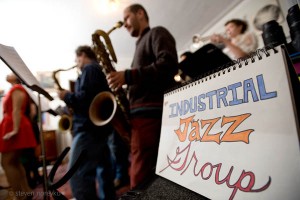Around 1980, my cousin Billy often used the word “biffit” to describe “10 pounds of x in a 5 pound y.” 1
Ever since our band broke the 10+ member barrier, The Industrial Jazz Group has had to figure out how to deal with the challenge of playing in smaller places. It’s fun to walk into a venue and do the mental tetris to figure out how we’re all gonna fit. Even though we have trombones and music stands and a keyboard and furiously gesticulating singers and dance moves and such, we always manage to make it work, and also to make it super-fun.
Friday (10/16) we played at The Green Line Café in Philadelphia and despite the teeny space, we ROCKED it. That was most definitely a biffit: 20,000 pounds of awesome crammed into a 5 pound bag… and by “5 pound bag” I mean an 80-square foot slab of floor that required the trombones to stand on the windowsill so they could play over the heads of the trumpets, and 9 tunes crammed into a 40 minute set. And by “20,000 pounds of awesome” I mean that our show contained booty-shakin’, hootin’ and hollerin’, audience-member smoochin’, and a big-time bangover the next morning. Or: to paraphrase Durkin: “On a 40-degree rainy night, we had the place rockin’ so hard that the venue had to turn on the air conditioning.” Oh hells yes!
On Saturday (10/17) we were invited to play at Galerie St. George, which is an old, huge, beautiful home on Staten Island that’s been turned into an art gallery. Despite the lipstick on this (absolutely gorgeous) pig, this show was still at its essence a house concert. You might be thinking, “How on earth can a 17-piece band play a house concert?” The answer is: With awesomeness, baby.
This event was another biffit: We stuffed 17 people, 15 music stands, a PA, a keyboard, and two mic stands into a 120-square foot center room of this house. Only the band could fit in this room, but the the audience sat in the surrounding spaces and they had a great time, goshdarnit. So did we! It was probably the most unusual setup we’ve ever had, and it was cool figuring out ways to engage the audience. I got to resurrect the signs by parading them around the house, which was good fun. I’ve missed those signs, and I plan on using them for most of our other gigs on the tour. Keep your eyes peeled!

Anyhoo, tomorrow (well, technically today as it’s 12:16am EST, despite what the header might say) we’ll be on a big, beautiful stage in Brooklyn at The Bell House. I’m very excited to share a bill yet again with Darcy James Argue’s Secret Society, and to experience for the first time Travis Sullivan’s Bjorkestra. The show starts at 7:30, and IJG goes on around 9. Can’t wait to see you there!
But now: Sleep. Today was a full day of mystery-gigging and bacon-cookie-making, but I’ll tell you all about those at another time.
——-
1 Where x = dingleberries and y = bag.
This is something I tell every big-band who’ll even pretend to listen: when it comes to big-band, compact is good. When playing, the instruments tend to be in harmonic relations to each other and that sets up a sympathetic resonance that synchronizes the waveforms such that, for example, the distinctive triangle waveforms of the reeds are IN PHASE with respect to each other. The physics then tells us that frequency-tuned and in-phase waveforms (ie “coherent”) when emitted within a space that is ‘small’ with respect to the wavelength will add not arithmetically but EXPONENTIALLY. Two saxphones are not twice as loud, they are FOUR TIMES the audio sound wave pressure.
What you have with a big-band is essentially a sonic “laser beam” (mrG does the DrEvil quotes gesture) that is directed full force at the audience.
Note that this effect is subverted by a PA if it is used to capture the unison lines and mix them for room playback (PA should only be to enhance or modify individual performances such as solos or unique instruments) and, here’s what I think is the kicker, the power-wave phenomenon would not be evident on ANY recordings, because the act of recording necessarily introduces a normalization of the waveform, and the multiple point-of-capture could only remain in perfect phase relation with great difficulty, and even then be nearly impossible to recreate at the playback.
It’s my guess that this is why it is so difficult to “turn people on” to big band from recordings alone: some people can use their imaginations to compensate, much as we routinely watch black and white TV or cinema and get some sense of the dramatic colour, and we can listen to AM radio even though a large portion of the sound spectrum is missing. For those who have played in a big-band or even just near big-band instruments, the prior experience compensates the experience, filling in the gaps; for those who have only experienced horns via recordings, which today is sadly a vast majority of the general music audience, the big-band sound on disc is “just a bunch of instruments”.
Bacon cookies?